
views
Gathering Information

Identify your recipient. Determine the identity of the other party and pinpoint your relationship with them. You want to send your letter to the person that has authority to make decisions. In most cases, this will be the person that owes you money or their attorney. Do not send your letter to an assistant or secretary. In addition to addressing the letter to the correct person, consider the relationship you have with that person. Is it a friend or relative? Is it someone you need to maintain a professional relationship with? Do you have to deal with this person in the future? Answering these questions will help you determine the tone of your letter.
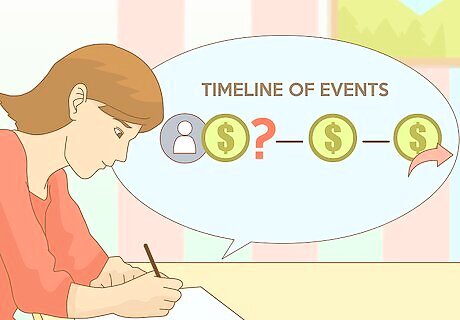
Create a timeline of events. Your demand letter is going to start with a statement of facts. Sit down and recreate the story that led to your dispute with the other party. Do this so your statement of facts is true, complete, and persuasive. To help, collect documents that help tell the story. For example, if you are writing a letter to someone that owes you money, find the initial purchase agreement, receipts, monthly statements, and other letters stating the person owes the money. Use these documents to get an idea of when and how the dispute arose.
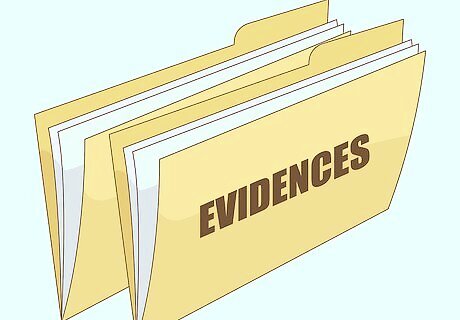
Collect evidence. Some documents will be included with your demand letter. These documents should be gathered before you start writing. For example, if you are in a contract dispute, find the contract and have it available while you are writing your letter. If your dispute concerns an outstanding bill, find that bill before you write.
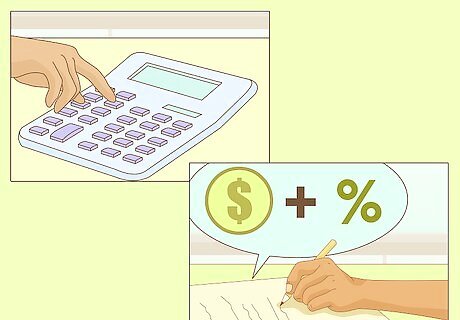
Calculate your remedy. When you demand payment of a certain amount, you need to be able to back up your request. If your demand is for a service, as opposed to money, be able to substantiate your claim. Do not make your request arbitrary. Before you start writing, calculate the amount of your request. For example, if one person owes you on three outstanding bills, each equaling $500, you will request $1,500. You may also request interest if that was a part of your initial agreement. Do not ask for $5,000 or some other arbitrary number. Any request you make will likely be scrutinized for its accuracy. The opposing party will not usually pay you until they have done their own research into the matter. This is why it is important to accurately calculate the amount of your request.

Find templates. Before you start writing, try to find demand letter templates online. A lot of legal services websites offer free templates. Also, some state sponsored websites will have examples available for you as well. Use your favorite search engine to try to find these templates. Try typing in "demand letter templates" or something similar.

Use state sponsored automated systems. Some states, for example California, offer a free service that will create a letter for you. All you have to do is answer a number of directed questions. Once you complete the questionnaire, a computer program will create a PDF version of your letter.
Writing Your Demand Letter

Place the date at the top of the letter. If you are writing your own letter, start by placing the date at the top left corner. The date is important as it will act as evidence of when you sent the demand letter. If you provide a deadline in your letter, it will be measured against the date written here as well.
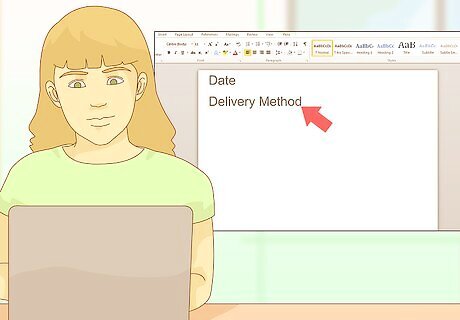
State the delivery method you are using. A couple lines down, let the other party know how you are sending the letter. This will set your expectation for a return letter or payment. For example, if you send your letter via priority mail with delivery confirmation, the other party could be expected to send a return letter using the same method. If possible, use a method that allows you to track your letter to ensure it gets to its recipient. In addition, request a return receipt when possible. When the letter is delivered, you will be sent a receipt showing that it was delivered. If you go to court, you can use this receipt to rebut any argument that the opposing party did not receive the notice.
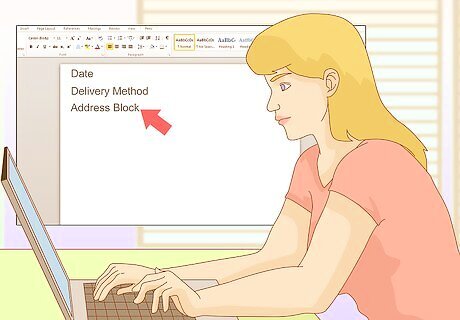
Create an address block. Next, draft an address block that includes the recipient's name and address. If your dispute goes to court, this letter may be used as evidence. If the letter doesn't include the recipient's name, it will be impossible to determine who the letter was meant for.
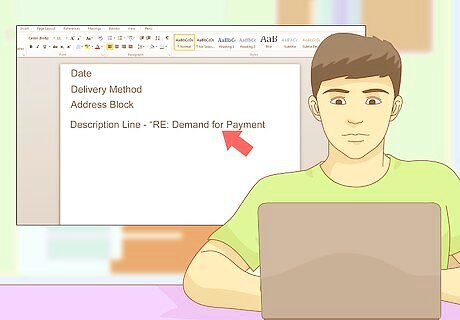
Include a description line. Your description line will briefly title the letter. For example, if you are demanding money from someone else, the description may state, "RE: Demand for Payment."

Address the recipient appropriately. Your salutation should confirm the identity of the recipient. In addition, you should address the other party as "Mr.", "Ms.", or "Mrs.".

Draft an opening paragraph. Your opening paragraph will start with a sentence about how much you are owed and why you believe you are owed it. Make this the focal point of your letter. The paragraph will also lay out the factual situation that led to the dispute you are now in. Be as in depth as possible but do not include irrelevant facts. Be concise but complete. If you end up in court, your letter will be read by the judge. Now is a great time to lay out the facts of the case as you see them. For example, your opening paragraph may say: "Please be advised that you owe me the sum of $5,000 because there is an outstanding bill for the purchase of a bike. On [date], you bought a bike from me for $5,000 and you executed a contract saying you would pay me by [date]."
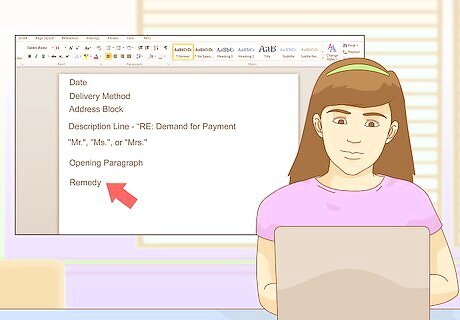
Describe the appropriate remedy. The second paragraph will tell the other party how you expect the payment to be delivered (or how the services will be provided); you will provide a deadline; you will explain who the payment can be made out to; and you will tell the other party where the payment can be sent. This paragraph should be written with a firm but polite tone. You do not want to attack the other party personally, but you want them to know you are serious. For example, you could say: "I expect payment in the amount of $5,000.00 made payable to me, 888 8th Street, Los Angeles CA, 90000 no later than February 12, 2016. (I can be reached at: (Telephone: (555) 555-5555).)"
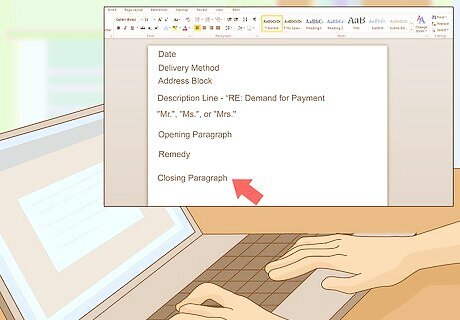
Write a closing paragraph. Your last body paragraph will ensure the other party has an understanding of the letter they are receiving. You should tell them that they will not receive another notice; that you will pursue any legal remedy you can; and you should let them know the possible consequences of going to court. For example, you may write: "This will be your only chance to settle this matter before I file suit against you in Small Claims Court. I am agreeable to a lump sum payment, or to a payment plan. Please contact me on or before February 12, 2016 for purposes of settling this matter. If I do not hear from you on or before February 12, 2016, I will file a lawsuit against you without further notice. It is in your best interest to settle this matter before a lawsuit is filed. If a judgment is obtained against you, it will negatively affect your ability to get credit, you will be ordered to pay court costs, and you will incur interest at a rate of 10% per annum. If you decide to ignore this demand for payment, I will further pursue all of its legal remedies without further notice to you. This letter serves as evidence that I have attempted to resolve this matter informally."
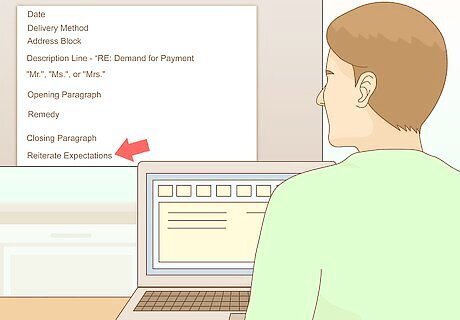
Reiterate your expectations. In a final closing sentence or two, you should again explain the situation. This conclusion should let the other party know that you expect payment and that if they ignore the notice a lawsuit may be filed. It is important not to skip this conclusion. You want to give the other party as many opportunities as possible to read and understand the consequences of their actions.
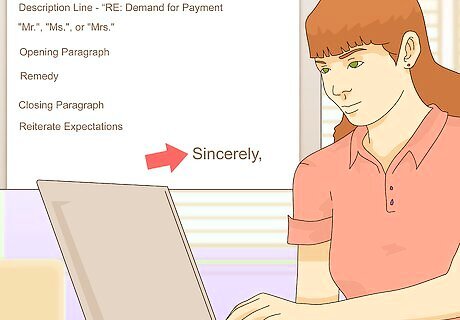
Close the letter. At the end of the letter, use "Sincerely" or "Thank You". Leave a couple of spaces after this for your signature. Below this space, include your name and contact information.
Sending Your Demand Letter
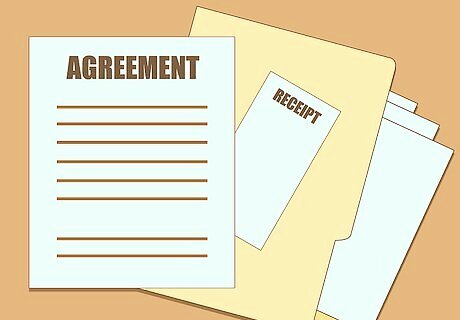
Attach exhibits. If your letter made reference to any contracts, statements, receipts, or any other document, include that document with your demand letter as an exhibit. If you go to court, these attachments may be useful if the other party argues they did not enter into an agreement with you, or that they were not sent statements or receipts.
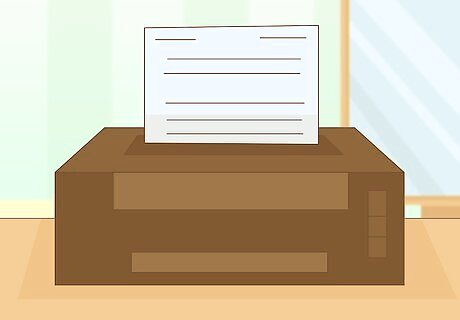
Print the letter. After the letter and all exhibits have been completed print the letter out. Use white paper and black ink.
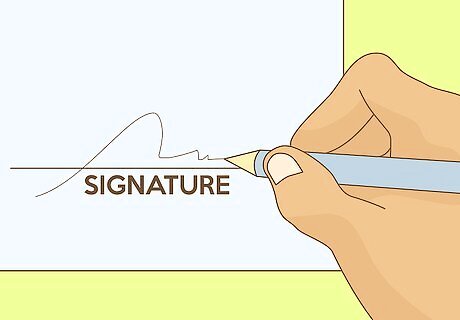
sign the letter. Using a black or blue pen, sign the demand letter in the space provided.
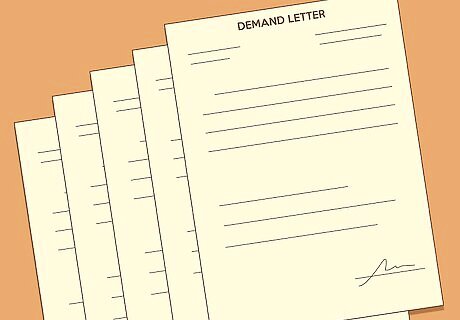
Make copies. Once you have placed your signature on the letter, make a couple of copies for yourself. In addition, keep all mailing receipts and correspondence from the other party. All of this may become important if your case goes to court.

Deliver the letter. Using the method you specified in the letter, send the demand to the other party.

Wait for a response. If the other party responds, negotiate with them or accept the payment if you receive it. If this happens, your dispute is resolved and the demand letter worked. If you get paid, send a letter thanking them for their response and payment. Let them know the dispute is resolved. If you do not get an answer, take any legal action you believe is appropriate.




















Comments
0 comment